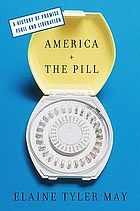America and the Pill is a highly readable, solidly-researched history of the development, distribution, and use of the birth control pill in America since the fifties. In seven brief chapters (I read the book in an afternoon) May describes the development and testing of the pill, its promotion by politicians and thought leaders interested in population-control, its use by married couples, the pill's role in the sexual revolution, the search for hormonal contraceptives for men, "questioning authority," and public use and perception of the pill today.
Clearly written as an introductory overview, this history begs for further elaboration on a number of points -- for example, the complicated relationship between individual use of birth control and national and international attempts to limit population growth. I would also be interested in a further exploration of how perceptions and use of the pill as a method of birth control relates to concerns about the spread of sexually-transmitted infections. For example, can we see a significant shift in what populations use the pill vs. the condom before and after the advent of AIDS/HIV?
I would also like to see further elaboration on the discourse concerning libido and hormonal birth control, since concerns over low libido remain a primary barrier to developing a male birth control pill, while women's persistent reporting of side-effects of the pill, including lowering of libido, have been glossed over as psychosomatic or unimportant when compared to the goal of limiting population growth. May offers an interesting historical perspective on this issue:
Although today's pill may not suppress libido more than the original oral contraceptive did, women today may well experience the effect of the pill differently. For many in the first generation of pill users, the intense fear of pregnancy diminished women's libido to such an extent that when they went on the pill and that fear disappeared, their sexual pleasure was increased considerably. Today there is no longer the terror of facing an illegal abortion, a ruined reputation, banishment to a home for unwed mothers, or a hasty marriage. ... With so many contraceptive options available to women today, some are unwilling to compromise their sexual pleasure of the convenience of the pill (149).While women's sexual pleasure is here understood in tension with their desire to manage their fertility, men's sexual pleasure (even their gender identity) is situated in their ability to procreate -- with no corresponding desire to limit family size. May quotes one medical doctor who in 1970 wrote in the Boston Globe that "generally speaking, a man equates his ability to impregnate a woman with masculinity. And all too often the loss of such ability really deflates his ego" (99). Presumably, many individual men in the 60s and 70s desired to take measures to ensure their partners did not get pregnant -- but while medical personnel and the public at large understood the fear of pregnancy and/or the desire to limit or space pregnancies as a legitimate concern for women, it appears they did not assume the same for men.
I felt at points that May was deliberately writing for a lay audience (that is, an audience of non-historians, or those unfamiliar with the history of twentieth-century medicine). For example, when she describes the clinical trials of the birth control pills which were undertaken without informed consent on populations such as mental patients and prisoners, she is at pains to point out that such trials were standard operating procedure until well into the 1980s when such violations of bodily autonomy and ethical mismanagement became the subject of public debate and regulation. At times, May's efforts to contextualize the clinical trials spills over into what feels like a bit too much post-facto justification. For example, when writing about the trials conducted in rural Puerto Rico in the mid-50s she writes,
The developers of the pill were particularly concerned about its safety. They put in place elaborate precautions to monitor the health of the women who took part in the trials, such as frequent medical exams and lab tests. Study participants in impoverished areas received medical attention vastly superior to what was normally available to them. ... By the standards of the day, the studies were scrupulously conducted (31).While all of these statements may be factually accurate (and I have no reason to suspect they are not), these passages feel a little too much as if May is trying to forestall protests about how these trials were conducted, protests which -- while not undermining the data collected -- would certainly be legitimate. What sort of pressure were poverty-stricken Puerto Rican women under to participate in the trials, for example, if the healthcare they received as a result was "vastly superior to what was normally available"? Obviously, it's important to understand these medical protocols in the historical context in which they happened, but it feels a little like May is trying to preempt discussion of ethical implications.
These passing editorial moments aside, May has written a great introduction to the historical context of the birth control pill that will be an enjoyable -- and historically robust -- read for anyone interested in the topic of women's and sexual/reproductive health, history of medicine, history of the family, and related fields.


No comments:
Post a Comment